Pellet stove heating is seeing impressive growth in the 21st century. The growth of the pellet market is being driven by means of two factors. Firstly the growing charge of fossil energy fuel such as oil and gas. The prices of these fuels is driven by unstable supply in addition to limited resources to meet growing global demand. Fossil fuel prices are also set to rise due to increased taxation because of the carbon emissions shaped. The continued rise in fossil fuel heating solutions will continue to make pellet stove heating solutions more affordable along with appealing. Pellet Fuel is also most wanted to fossil fuels, are pellet fuels from wood resources are a carbon neutral form of energy. As biomass in addition to other wood materials are already part of the current carbon cycle, their burning does not place any additional carbon into the atmosphere. Biomass energy pellets can even be carbon negative, by using the ash produced as a soil conditioner.
Click Here For Your Pellet Range Guide!
By way of far the most common type of energy pellet used for abode heating is the wood pellet, or more specifically the premium wood pellet. Premium biomass pellets manufacture around 0.5% ash, in addition to are therefore the lowest maintenance pellet energy obtainable. Though you will obviously have to pay for this convenience, as premium pellet fuels are the most expensive pellet fuels on the market. Other grades of biomass pellets are accessible, yet as they generally contain small brush residue in addition to bark, their ash percentage is usually more around 2%. No contaminated biomass residues should be used for fuel pellet use, as the contaminates during burning could manufacture a health along with environmental risk. If you obtain energy pellets which generate a strange smell during incineration, contact you local authority to have the pellets tested. Other biomass materials such as switchgrass plus straw can be used to produce energy pellets. In fact one of the most promising raw materials is hemp. Hemp energy pellets are very low ash, along with pose no increased corrosion risk or form clinker formations in the pellet stove.
Not all pellet stove heating solutions are equal, far from it. There is a wide collection of abilities in the pellet stove market from product to product. However these differences are not well known or understood. The core focus of these differences related to the stoves abilities to handle different types and grades of energy pellets. The main differences in stove design which affect these issues is the design of the burn pot and pellet feed system. These features when choosing a pellet stove heater are over looked, on the other hand impact directly on the efficiency in addition to reliability of the pellet stove. Most pellet stoves are built around a drop down burn pot. Manufactures prefer this design, as it is the cheapest to create, though has running issues with all but perfect pellet fuels.
 Alternative Energy HQ solar power for homes, wind energy, and bio fuel issues
Alternative Energy HQ solar power for homes, wind energy, and bio fuel issues






